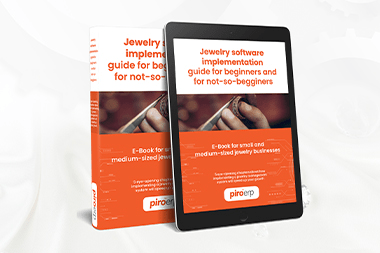My team has implemented the PIRO jewelry management software at more than 100 companies so far. These companies are mainly small and medium-sized jewelry companies that are indeed not changing their management system too often, many of them are implementing a true management automation software for the first time.

Some of the implementation projects were delayed because of a reason that you might find surprising. In lack of an exact word for this issue, I can only describe it. I’m referring to the scenario when business owners are ready to implement a new system but they are looking for the same system logic as their previous software or toolset has had.
From a static solution to an automated solution

If we look at the ground base of a management software, one characteristic has to be definitely highlighted. And this is the automation. Many of the jewelry business owners are committing to implement a new solution because of the lack of automation in management work processes. In some cases, they use some kind of software but they are still doing significant manual work, meaning that the software they use is not appropriate for their needs.
A complete management software can automate the management of orders, inventory, production, and sales and connect all these processes in a centralized database. Excel sheets would never be able to do that. Excel is great to do mathematical calculations, however, it will never be able to connect sophisticated processes. In order to include high-level automation, you need a software that is built along a different architecture and logic than Excel.
 For this reason, when a client is asking to configure the software just like Excel, it sounds like a non-sense to us. Why would you use the software like an Excel sheet, when in fact you are looking to move away from Excel spreadsheets? If we would configure our system that way, basically we would downgrade it to the level of an Excel spreadsheet.
For this reason, when a client is asking to configure the software just like Excel, it sounds like a non-sense to us. Why would you use the software like an Excel sheet, when in fact you are looking to move away from Excel spreadsheets? If we would configure our system that way, basically we would downgrade it to the level of an Excel spreadsheet.
Same problem, different solution
There is also another type of client who is already using some sort of system but struggling to mentally detach themselves from the legacy software’s architecture. These business owners would like to see the same data input method, the same process management as in the previous software.
The issue with this is that most management systems solve the same problems differently and their dataflow is different. Comparing two systems is like comparing a pear to an orange.

When you would like to implement a new system, you should be prepared that some things will change. Some things will work better compared to the old system and some will follow a completely new way of data handling.
You know, this has worked differently in our previous system, can we do the same in yours?
This is the question that often raises concern in software implementers, as they perfectly know its pitfalls. Implementation projects often get delayed because too much time and energy is invested in trying to configure the system according to the logic of a different system, not to mention the costs that are involved in custom developments, trying to redesign the software architecture.
Funnily enough, probably nobody told Apple that “Your iPhone is great but can I get it with a rotary dial? That’s how I used to dial.”
I would like to close this blogpost with this little joke and as a takeaway, I would suggest business owners to be flexible and open-minded when they are implementing a new management software.
For most system users, getting used to new routines is not an issue. Typically, the initial fear and resistance to something new are exaggerated and unfounded and within a few months, system users will have gotten used to the change and will have realized that new, automated processes are even more effective.
Are You ready for a change? Feel free to book a demo!






